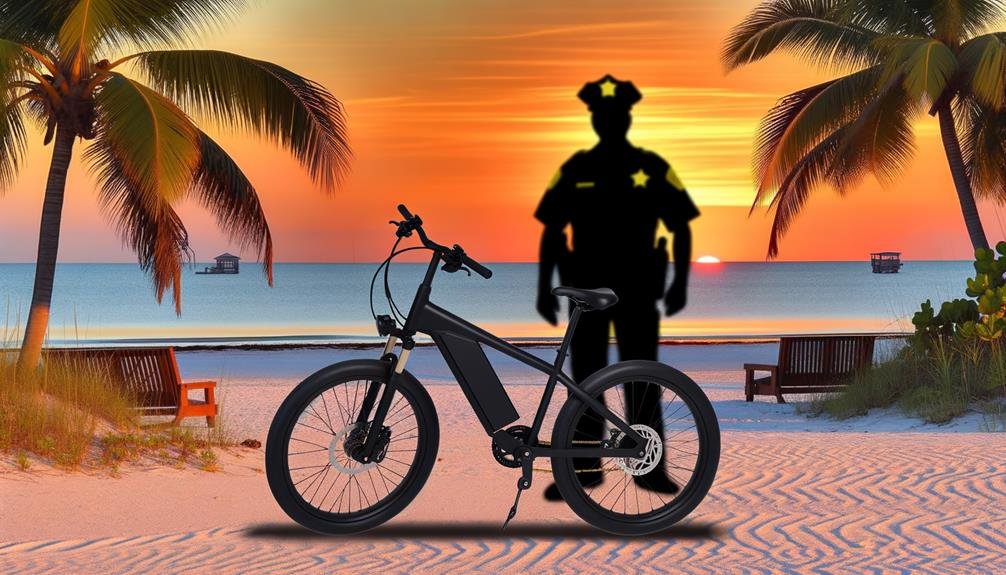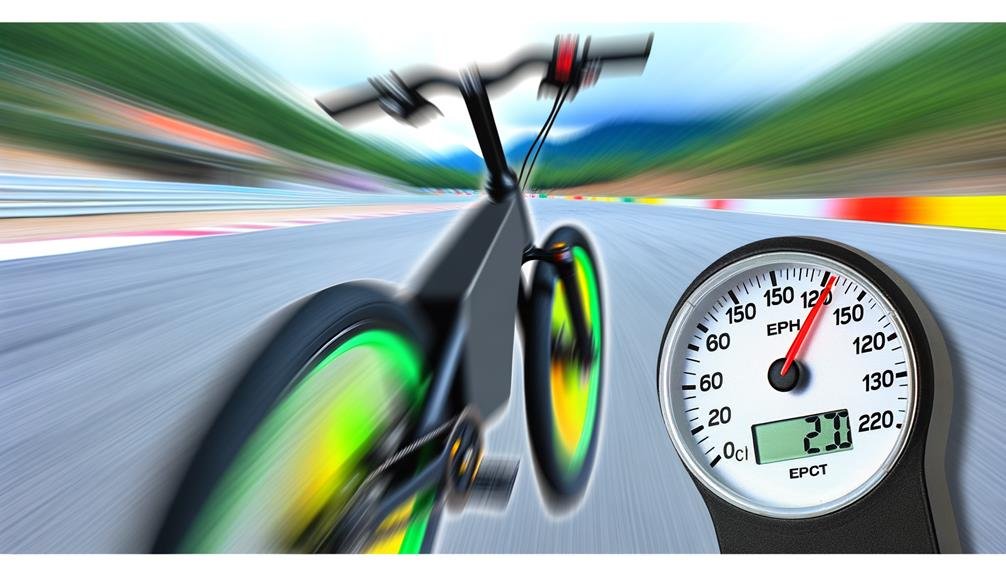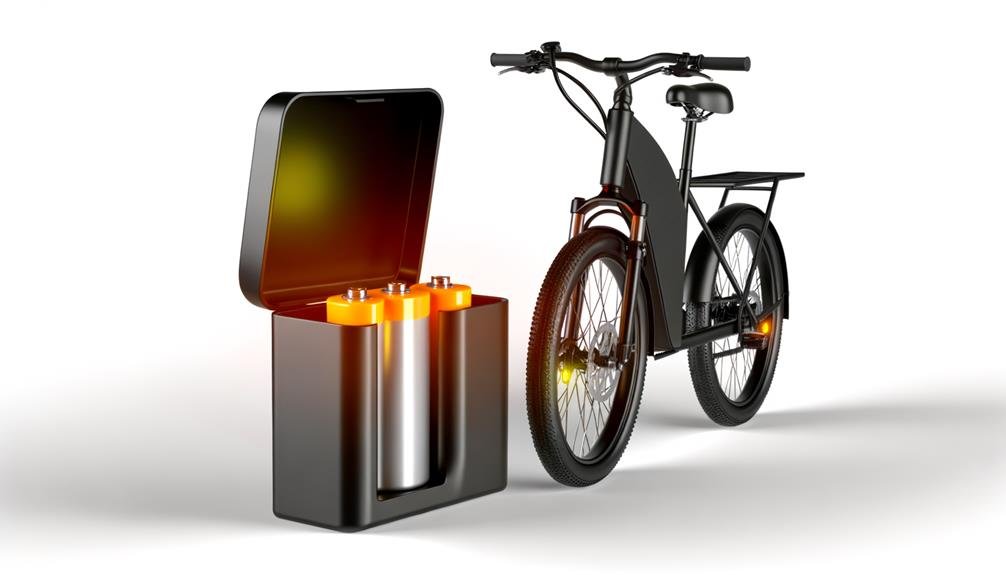Charles Miller is a veteran bike enthusiast with over 12 years of experience dealing with bikes as a mechanic. Despite immense love and expertise for...
Choosing the right motor size for an electric bike is like selecting the heart for a mechanical beast – it's the element that powers your ride and defines your biking experience. We're here to navigate the complex world of e-bike motors, exploring factors such as power, speed, battery life, and your individual riding needs.
The perfect motor size can vary widely based on these variables, so it's crucial to find your unique fit. But what exactly should we consider when deciding on the motor size? And how does the motor impact the overall performance and cost of the e-bike?
Let's dive into this intricate topic and uncover the answers.
Key Takeaways
- Factors to consider when choosing a motor size for an electric bike include power requirements, level of assistance needed, impact on battery life, and impact on price.
- Different motor sizes are suitable for different riding needs, with smaller motors being better for flat ground riding and larger motors for navigating hills or off-road terrain.
- Low power motors are energy efficient, lighter, more affordable, and require less maintenance, but they struggle with uphill climbs and have lower acceleration and speed.
- High power motors offer increased speed and range, are ideal for longer trips and challenging terrains, assist with uphill climbs, and can handle heavier loads and tougher conditions.
Understanding Electric Bike Motors
When choosing the appropriate motor for an electric bike, it's essential to consider power requirements based on desired speed and terrain, the level of assistance needed, and the potential impact of motor size on battery life and price. Understanding electric bike motors is paramount to making an informed decision.
Ebike Motor Sizes vary greatly, and each size caters to a specific type of riding. A smaller motor might suffice for flat ground riding, while a larger one may be required for navigating light hills or off-road terrain. We can't overlook the potential dangers posed by larger motors, but for heavier riders or those looking for off-road performance, it's a worthy trade-off.
The type of e-bike you choose also influences the optimal motor size. A mid-drive motor might be more suitable for an e-bike designed for hill climbing, due to its balanced weight distribution. It's also important to consider tire size in relation to motor size.
To navigate this complex landscape, it's beneficial to consult with experts or experienced riders. They can provide personalized assistance, helping you understand the nuances of e-bike motor sizes and select the best fit for your needs.
Low Power Motors: Pros and Cons
Building on our understanding of e-bike motor sizes, we'll now analyze the pros and cons of opting for low power motors in electric bikes. Determining the size motor that is right for you depends on your specific needs and circumstances, and understanding the benefits and drawbacks of smaller motors can be instrumental in making an informed decision.
Low power motors, typically found in smaller electric bike motors, are known for their energy-efficiency. They tend to offer longer battery life, providing more extended rides, and are often more affordable, making them a budget-friendly choice for many. Additionally, due to their lighter weight, they contribute to a more agile and maneuverable ride, and require less maintenance, reducing long-term costs.
However, everything has its trade-offs. Low power motors may struggle with uphill climbs and challenging terrains, and might not deliver the same level of acceleration and speed as their higher power counterparts. They may also not be suitable for heavier riders or for carrying heavy loads.
| Pros | Cons |
|---|---|
| Energy efficient, longer battery life | Struggle with uphill climbs |
| Lighter, more maneuverable | Lower acceleration, speed |
| More affordable | Not suitable for heavy riders, loads |
| Require less maintenance | Limited performance, versatility |
High Power Motors: The Benefits
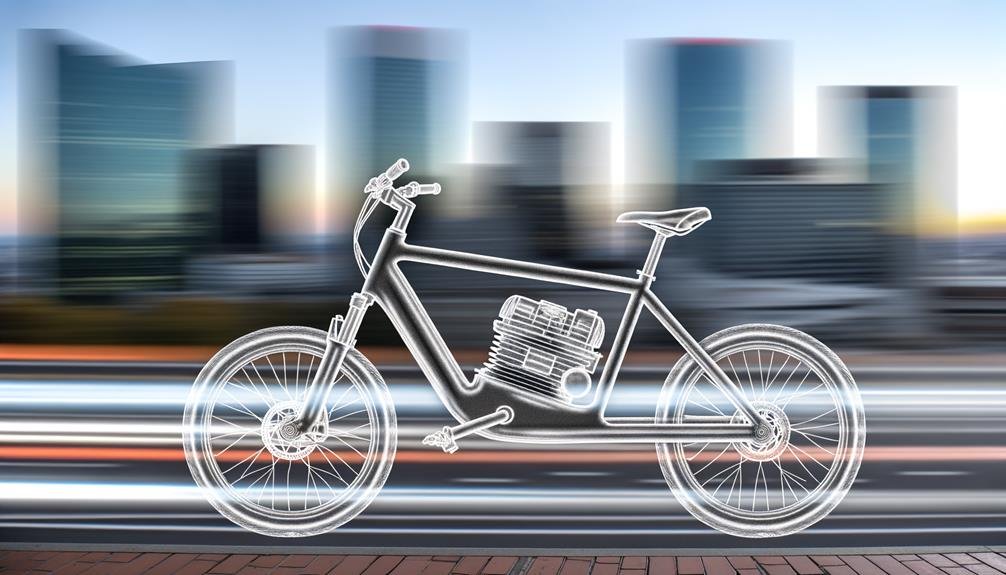
Diving into the realm of high power motors, we find numerous benefits, notably their ability to provide increased speed and range, which proves ideal for longer trips and challenging terrains. These motor types significantly assist with uphill climbs, reducing physical strain and making biking an accessible activity for various fitness levels.
Larger motors, thus, extend the scope of electric biking, making it a truly versatile mode of transportation. They give us the ability to handle heavier loads and tougher conditions, reinforcing the notion that the question ‘what size motor is best for electric bike' isn't a one-size-fits-all answer.
High power motors: the benefits go beyond just speed and range. They contribute to sustainable mobility solutions, making them an eco-friendly choice. By choosing larger motors, we don't just enhance our biking experience, we actively participate in the movement towards eco-conscious transportation solutions.
In our pursuit of belonging to a community that values technology, health, and sustainability, we recognize the importance of understanding the intricacies of electric bike motors. Thus, considering high power motors as a viable option reflects an informed and responsible choice for both individual and collective benefits.
Comparing Top Electric Bike Motors
As we shift our focus to comparing top electric bike motors, we'll be considering key aspects such as:
- Understanding the fundamentals of these motors
- Discussing popular brands
- Analyzing the relationship between motor power and performance
We're not just looking at who makes them, but what makes them tick – their power, efficiency, and overall impact on your biking experience.
It's about finding the right balance between power, performance, and practicality to suit your specific needs.
Understanding Electric Bike Motors
When it comes to choosing the right motor for your electric bike, one must weigh factors such as power requirements, impact on riding experience, motor sizes, specific needs, and performance characteristics. Understanding electric bike motors is crucial to finding the perfect match.
Assessing the desired speed and terrain will help determine power requirements. Larger motors may provide more assistance, but also potentially introduce dangers. When comparing Ebike motors, consider their impact on battery life and cost.
Tailor your choice to your specific needs: flat ground, hills, weight, and terrain. Finally, recognize the capabilities and limitations of different motors: top speed, pedal assist, power, and acceleration.
Join us on this journey of understanding electric bikes, and together, we'll find the perfect fit.
Popular E-Bike Motor Brands
Often, we find ourselves comparing popular e-bike motor brands such as Bosch, Shimano, Fazua, Yamaha, and Specialized, each offering unique benefits like increased speed and range, assistance with uphill climbs, and reduced effort during long rides.
It's crucial to understand that each type of motor is designed to meet specific needs:
- For mountain biking enthusiasts, motors like Bosch's Performance Line are a good option due to their high torque.
- Yamaha motors are a good choice for those seeking a balance between power and range.
- Shimano motors, known for their versatility, are a good option for various riding conditions.
- Specialized, with its customizable power delivery, suits those desiring a tailored riding experience.
Through careful comparison, we can find the motor that fits our biking lifestyle.
Motor Power Vs Performance
Having compared the offerings of different e-bike motor brands, we're now ready to dig deeper into the relationship between motor power and performance, as this crucial aspect can significantly influence our biking experience.
When contemplating what size motor is best for electric bike, we must weigh motor power vs performance. The type of riding we're planning also plays a pivotal role.
For example, steep terrains demand extra power, which larger motors can provide. However, these can potentially drain the battery faster, affecting performance over longer rides.
Conversely, smaller motors may be sufficient for flat terrains or casual biking, offering a balance between power and performance.
Choosing Your Ideal Motor Size
To choose the ideal motor size for our electric bike, we need to consider several factors including the power requirements based on our desired speed and terrain, the level of assistance needed, cost considerations, and potential impacts on battery life and price.
When asking 'what size motor is best for electric bike?', it's not a one-size-fits-all answer. We must consider:
- The power requirements: how much power and speed we want from our e-bike.
- The level of assistance: how much pedaling assistance we need.
- The cost: larger motors often come with a higher price tag.
- The battery life: a larger motor may drain the battery faster.
By carefully considering these factors, we can find the right motor size for our needs and budget.
When choosing your ideal motor size, don't forget to factor in your riding style and the type of terrain you'll be covering. Lower wattage motors are great for recreational rides and short trips, while higher wattage motors can handle longer trips on difficult terrain. Ultimately, the best motor size for your electric bike depends on your personal needs and preferences.
The Impact of Terrain on Motor Size
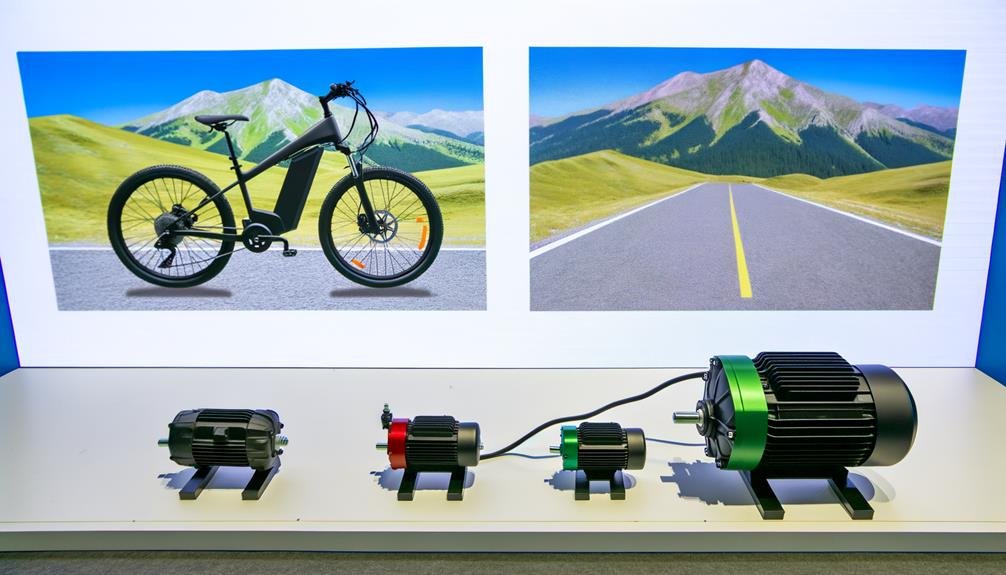
When we're tackling different terrains on our electric bike, the motor size becomes a key factor in maintaining optimal performance and efficiency. The impact of terrain on motor size is significant, influencing not only the bike's power requirements but also its battery life. Rough, challenging terrains like steep inclines or off-road conditions demand larger motors for improved torque and climbing ability, ensuring that we're not left struggling halfway up a hill.
It's clear that what size motor is best for an electric bike isn't a one-size-fits-all answer. It's contingent on the type of terrain we regularly traverse. Depending on how fast we want to conquer these terrains, our motor size will vary. If our goal is to reach top speed on flat surfaces, a smaller motor will suffice. But if we're tackling hilly or uneven landscapes, we'll need a larger motor.
Motor Size and Battery Life Relationship
We're now moving on to explore the relationship between motor size and battery life in electric bikes.
It's crucial to understand that larger motors, while powerful, can significantly shorten battery life and reduce riding range.
Balancing motor size and battery capacity is key to achieving optimal performance and efficiency in an e-bike system.
Understanding Motor-Battery Dynamics
In choosing the best motor for an electric bike, it's essential to understand the dynamics between motor size and battery life, as this relationship significantly affects the bike's performance and longevity. To fully grasp what size motor is best for an electric bike, we must delve into understanding motor-battery dynamics.
- Larger motors consume more power, shortening battery life.
- Conversely, smaller motors may extend battery life but lack power for long rides.
- Striking a balance between motor size and battery capacity ensures optimal performance.
- Using the pedal assist feature can help conserve battery life, letting you go 20 miles or more.
Optimal Motor Size Selection
To select the optimal motor size for an electric bike, it's crucial to grasp the correlation between motor size and battery life, as this directly impacts the bike's speed, power, and overall performance. Larger motor sizes can provide stronger uphill rides and faster speeds, yet may drain battery life quicker.
Consider your riding needs and consult our RideFinancingBuyers Guide for a detailed understanding of motor size selection. Our StylesAffiliate Program offers a range of ebike motors to suit various riding scenarios, from off-roading to commuting.
Impact on Riding Performance
Having explored how to select the optimal motor size, let's now analyze how this decision impacts your electric bike's riding performance, particularly in relation to battery life.
A motor's size directly affects the bike's capacity to cover distances, and its power consumption can significantly impact battery life.
- A larger motor can offer better performance, but it can also drain the battery quicker, thus reducing your bike's range to potentially less than 49 miles.
- If you frequently ride uphill or off-road, a larger motor provides the power needed but may require a larger battery to maintain a decent range.
- Striking a balance between motor size and battery capacity is crucial to ensure optimal riding performance.
- Always consider the trade-off between motor size and battery life when consulting the RideFinancingBuyers GuideFind a RetailerBulk OrderDiscount CodesVisit.
Frequently Asked Questions
What Size Motor Is Best for Ebike?
"We believe it's not merely about size, but motor efficiency, maintenance, durability, and torque considerations. The 'best' ebike motor depends on personal needs and riding conditions. We're here to find the perfect fit for you."
How Big of an Electric Motor Do I Need on a Bike?
We've got to assess motor efficiency, speed requirement, terrain considerations, and bike weight. For flat terrains, we'd recommend a 250-watt motor. For most scenarios, a 500-watt one will do, and 750-watt for challenging terrains.
How Powerful of an Ebike Motor Do I Need?
We'd need to consider motor efficiency, terrain, rider's weight, and battery capacity. It's not just about power, but also about how effectively the motor uses that power to suit our specific cycling conditions.
How to Choose Ebike Motor?
We're choosing an e-bike motor, we're considering motor efficiency, terrain type, rider's weight, and battery compatibility. It's not just about size, but the perfect balance of these factors for a smooth ride.
Conclusion
In sum, finding the perfect motor size for your e-bike is a journey of balance.
It's like finding the right gear in a well-oiled machine, considering factors such as power needs, budget, terrain, and rider weight.
A 250-watt motor could be your sweet spot, or you might require the muscle of a 750-watt beast.
Remember, the motor's size directly influences battery life, so it's a dance of power and endurance.
Choose wisely, and your e-bike will serve you faithfully.

Charles Miller is a veteran bike enthusiast with over 12 years of experience dealing with bikes as a mechanic. Despite immense love and expertise for his Tacoma, he rides his Trek Ebike more. Anytime you meet him, you’ll either hear him talking about Bikes, or writing about all things bikes and cars on this blog.
More Posts
